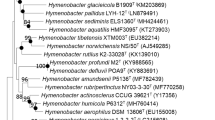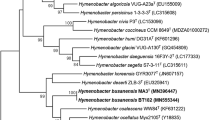Abstract
Two novel Gram-stain-negative, non-motile, aerobic, rod-shaped, circular, convex, red-colored and UV-tolerant strains BT594T and BT646T were isolated from soil collected in Guri city (37° 36′ 0″ N, 127° 9′ 0″ E) and Gwangju city (37° 22′ 0″ N, 127° 17′ 0″ E), respectively, South Korea. 16S rDNA sequence analysis indicated that strains BT594T and BT646T belong to a distinct lineage within the genus Hymenobacter (family Hymenobacteraceae, order Cytophagales, class Cytophagia, phylum Bacteroidetes, kingdom Bacteria). The 16S rDNA gene sequence similarity between the two strains BT594T and BT646T was 96.2%. The strain BT594T was closely related to Hymenobacter psychrotolerans Tibet-IIU11T (97.0% 16S rDNA gene similarity) and Hymenobacter tibetensis XTM003T (96.3%). The strain BT646T was closely related to Hymenobacter psychrotolerans Tibet-IIU11T (98.6%), Hymenobacter kanuolensis T-3 T (96.8%) and Hymenobacter perfusus LMG 26000 T (96.7%). The two strains were found to have the same quinone system, with MK-7 as the major respiratory quinone. The major polar lipids of strains BT594T and BT646T were phosphatidylethanolamine (PE) and aminophospholipids (APL). The major cellular fatty acids of strain BT594T were anteiso-C15:0 (17.9%), iso-C15:0 (16.1%) and summed feature 3 (C16:1 ω6c / C16:1 ω7c) (10.0%). The major cellular fatty acids of strain BT646T were summed feature 3 (C16:1 ω6c / C16:1 ω7c) (18.3%), C16:0 (17.2%) and summed feature 4 (iso-C17:1 I / anteiso-C17:1 B) (14.5%). Based on the polyphasic analysis, strains BT594T and BT646T can be suggested as two novel bacterial species within the genus Hymenobacter and the proposed names are Hymenobacter guriensis and Hymenobacter duratus, respectively. The type strain of Hymenobacter guriensis is BT594T (= KCTC 21863 T = NBRC 114853 T) and the type strain of Hymenobacter duratus is BT646T (= KCTC 21915 T = NBRC 114854 T).


Similar content being viewed by others
References
Munoz R, Rossello-Mora AR (2017) Revised phylogeny of Bacteroidetes and proposal of sixteen new taxa and two new combinations including Rhodothermaeota phyl. nov. Syst Appl Microbiol 39:281–296
Zhang L, Dai J, Tang Y, Luo X, Wang Y, An H, Fang C, Zhang C (2009) Hymenobacter deserti sp. nov., isolated from the desert of Xinjiang. China Int J Syst Evol Microbiol 59:77–82
Han L, Wu SJ, Qin CY, Qin CY, Zhu YH, Lu ZQ, Xie B, Lv J (2014) Hymenobacter qilianensis sp. nov., isolated from a subsurface sandstone sediment in the permafrost region of Qilian Mountains, China and emended description of the genus Hymenobacter. Antonie Van Leeuwenhoek 105:971–978
Kim MK, Kang MS, Srinivasan S, Lee DH, Lee SY, Jung HY (2017) Complete genome sequence of Hymenobacter sedentarius DG5BT, a bacterium resistant to gamma radiation. Mol Cell Toxicol 13:199–205
Sedlacek I, Pantucek R, Kralova S, Maslanova I, Holochova P, Stankova E, Vrbovska V, Svec P, Busse HJ (2019) Hymenobacter amundsenii sp. nov. resistant to ultraviolet radiation, isolated from regoliths in Antarctica. Syst Appl Microbiol 42:284–290
Chung AP, Lopes A, Nobre MF, Morais PV (2010) Hymenobacter perfusus sp. nov., Hymenobacter flocculans sp. nov. and Hymenobacter metalli sp. nov. Three new species isolated from an uranium mine waste water treatment system. Syst Appl Microbiol 33:436–443
Feng GD, Zhang J, Chen W, Wang SN, Zhu H (2020) Hymenobacter fodinae sp. nov. and Hymenobacter metallicola sp. nov., isolated from abandoned lead-zinc mine. Int J Syst Evol Microbiol 70:4867–4873
Jiang F, Danzeng W, Zhang Y, Zhang Y, Jiang L, Liu J, Lu L, Fan W, Peng F (2018) Hymenobacter rubripertinctus sp. nov., isolated from Antarctic tundra soil. Int J Syst Evol Microbiol 68:663–668
Klassen JL, Foght JM (2011) Characterization of Hymenobacter isolates from victoria upper glacier, Antarctica reveals five new species and substantial non-vertical evolution within this genus. Extremophiles 15:45–57
Dai J, Wang Y, Zhang L, Tang Y, Luo X, An H, Fang C (2009) Hymenobacter tibetensis sp. nov., a UV-resistant bacterium isolated from Qinghai-Tibet plateau. Syst Appl Microbiol 32:543–548
Yu SL, Lee SK (2017) Ultraviolet radiation: DNA damage, repair, and human disorders. Mol Cell Toxicol 13:21–28
Kang MS, Srinivasan S (2018) Complete genome sequence of Methylobacterium sp. 17Sr1-43, a radiation-resistant bacterium. Mol Cell Toxicol 14:453–457
Kim MK, Kim JY, Kim SJ, Kim MJ, Lee JY, Kim CG, Srinivasan S (2017) Complete genome sequence of Spirosoma pulveris JSH 5–14T, a bacterium isolated from a dust sample. Mol Cell Toxicol 13:373–378
Maeng S, Kim MK, Subramani G (2020) Hymenobacter jejuensis sp. nov., a UV radiation-tolerant bacterium isolated from Jeju Island. Antonie Van Leeuwenhoek 113:553–561
Sathiyaraj G, Kim MK, Kim JY, Kim SJ, Jang JH, Maeng S, Kang MS, Srinivasan S (2018) Complete genome sequence of Microvirga sp. 17mud 1–3, a radiation-resistant bacterium. Mol Cell Toxicol 14:347–352
Sathiyaraj G, Kim MK, Kim JY, Kim SJ, Jang JH, Maeng S, Kang MS, Srinivasan S (2018) Complete genome sequence of Nibribacter radioresistens DG15C, a radiation resistant bacterium. Mol Cell Toxicol 14:323–328
Srinivasan S, Lee SY, Kim MK, Jung HY (2017) Complete genome sequence of Hymenobacter sp. DG25A, a gamma radiation-resistant bacterium isolated from soil. Mol Cell Toxicol 13:65–72
Cappuccino JG, Sherman N (2010) Microbiology: a Laboratory Manual, 9th edn. Benjamin Cummings
Weisburg WG, Barns SM, Pellerier DA, Lane DJ (1991) 16S ribosomal DNA amplification for phylogenetic study. J Bacteriol 173:697–703
Yoon SH, Ha SM, Lim J, Kwon S, Chun J (2017) A large-scale evaluation of algorithms to calculate average nucleotide identity. Antonie Van Leeuwenhoek 110:1281–1286
Jeon YS, Lee K, Park SC, Kim BS, Cho YJ, Ha SM, Chun J (2014) EzEditor: a versatile sequence alignment editor for both rRNA- and protein-coding genes. Int J Syst Evol Microbiol 64:689–691
Kumar S, Stecher G, Li M, Knyaz C, Tamura K (2018) MEGA X: molecular evolutionary genetics analysis across computing platforms. Mol Biol Evol 35(6):1547–1549
Saitou N, Nei M (1987) The neighbor-joining method: a new method for reconstructing phylogenetic trees. Mol Bio Evol 4:406–425
Felsenstein J (1981) Evolutionary trees from DNA sequences: a maximum likelihood approach. J Mol Evol 17:368–376
Fitch WM (1971) Toward defining the course of evolution: minimum change for a specific tree topology. Syst Zool 20:406–416
Felsenstein J (1985) Confidence limit on phylogenies: an approach using the bootstrap. Evolution 39:783–791
Kimura M (1983) The Neutral Theory of Molecular Evolution. Cambridge University Press, Cambridge
Tatusova T, DiCuccio M, Badretdin A et al (2016) NCBI prokaryotic genome annotation pipeline. Nucleic Acids Res 44:6614–6624
Lee I, Ouk Kim Y, Park SC, Chun J (2016) OrthoANI: an improved algorithm and software for calculating average nucleotide identity. Int J Syst Evol Microbiol 66:1100–1103
Meier-Kolthoff JP, Auch AF, Klenk HP, Göker M (2013) Genome sequence-based species delimitation with confidence intervals and improved distance functions. BMC Bioinformatics 14:60
Komagata K, Suzuki K (1987) 4 Lipid and cell-wall analysis in bacterial systematics. Method Microbiol 19:161–207
Minnikin DE, O’Donnell AG, Goodfellow M, Alderson G, Athalye M, Schaal A, Parlett JH (1984) An integrated procedure for the extraction of bacterial isoprenoid quinones and polar lipids. J Microbiol Meth 2:233–241
Sasser M (1990) Identification of Bacteria by Gas Chromatography of Cellular Fatty Acids. MIDI Technical Note 101, pp. 1–7. Newark DE: MIDI Inc
Hiraishi A, Ueda Y, Ishihara J, Mori T (1996) Comparative lipoquinone analysis of influent sewage and activated sludge by high performance liquid chromatography and photodiode array detection. J Gen Appl Microbiol 42:457–469
Feng GD, Zhang J, Zhang XJ, Wang SN, Xiong X, Zhang YL, Huang HR, Zhu HH (2019) Hymenobacter metallilatus sp. nov., isolated from abandoned lead-zinc ore. Int J Syst Evol Microbiol 269:2142–2146
Richter M, Rossello-Mora R (2009) Shifting the genomic gold standard for the prokaryotic species definition. Proc Natl Acad Sci USA 106:19126–19131
Su S, Chen M, Teng C, Jiang S, Zhang C, Lin M, Zhang W (2014) Hymenobacter kanuolensis sp. nov., a novel radiation-resistant bacterium. Int J Syst Evol Microbiol 64:2108–2112
Zhang G, Niu F, Busse HJ, Ma X, Liu W, Dong M, Feng H, An L, Cheng, (2008) Hymenobacter psychrotolerans sp. nov., isolated from the Qinghai-Tibet Plateau permafrost region. Int J Syst Evol Microbiol 58:1215–1220
Acknowledgements
This work was supported by a research grant from Seoul Women’s University (2021) and by a grant from the National Institute of Biological Resources (NIBR), funded by the Ministry of Environment (MOE) of the Republic of Korea (NIBR202002108). This research was supported by the MIST (Ministry of Science, ICT), Korea, under the National Program for Excellence in SW), supervised by the IITP (Institute of Information & communications Technology Planing & Evaluation) in 2021 (2016-0-00022). We are grateful to Dr. Aharon Oren (The Hebrew University of Jerusalem, Israel) for helping with the etymology.
Author information
Authors and Affiliations
Corresponding authors
Additional information
Publisher's Note
Springer Nature remains neutral with regard to jurisdictional claims in published maps and institutional affiliations.
Supplementary Information
Below is the link to the electronic supplementary material.
Rights and permissions
About this article
Cite this article
Damdintogtokh, T., Cha, IT. & Kim, M.K. Hymenobacter guriensis sp. nov., and Hymenobacter duratus sp. nov., Radiation-Resistant Species Isolated from Soil in South Korea. Curr Microbiol 78, 3334–3341 (2021). https://doi.org/10.1007/s00284-021-02517-6
Received:
Accepted:
Published:
Issue Date:
DOI: https://doi.org/10.1007/s00284-021-02517-6




